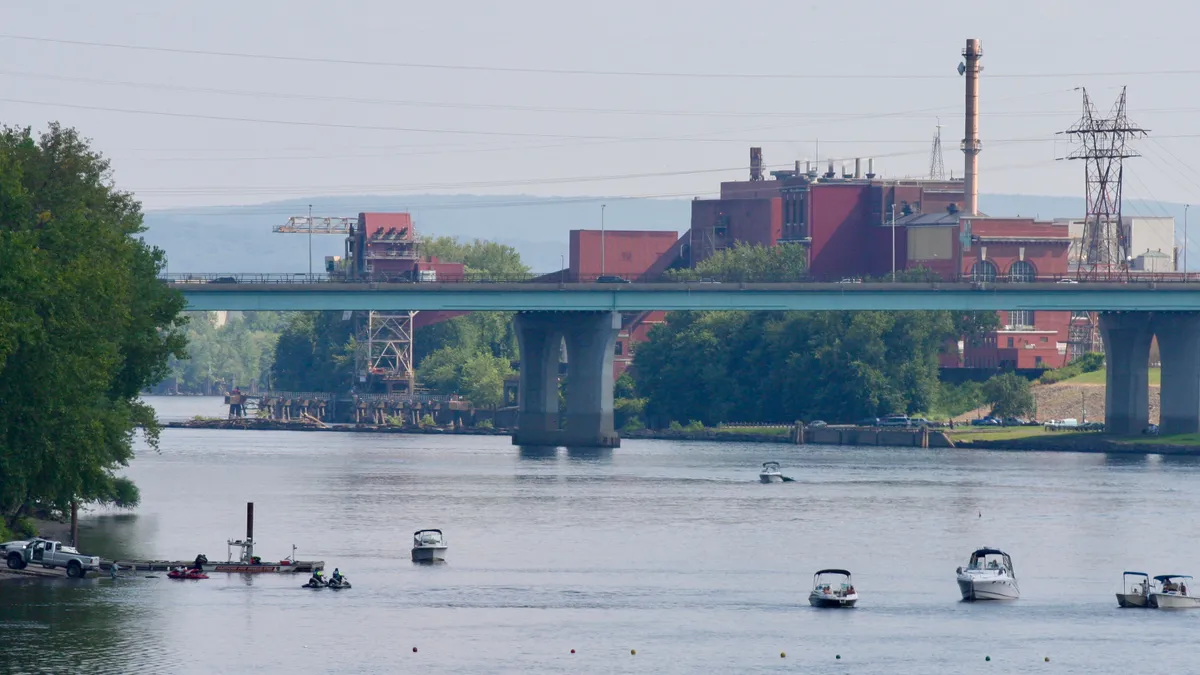Dive Brief:
- A major waste-to-energy facility in Connecticut closed last week, taking an estimated 720,000 tons per year of annual disposal capacity out of the state.
- The facility’s operator, the quasi-public Materials Innovation and Recovery Authority, is still managing an estimated 70,000 tons per year for 28 members towns through two transfer stations. That material is being transferred by trucking company Enviro Express to a landfill in the Scranton, Pennsylvania, area.
- Next steps for the region’s waste infrastructure remain under discussion. MIRA President Tom Kirk said “everyone’s waiting with bated breath” for a legislative task force report due by Jan. 1. The report is the result of a bill, passed in March, that calls for a study on “the transition from the disposal management operations of [MIRA].”
Dive Insight:
MIRA’s refuse-derived fuel facility in Hartford, converted from a former coal plant in the 1980s, previously handled about one-third of Connecticut’s waste and was a key part of the state’s efforts to move away from landfills. A complex, multiyear process to refurbish the facility and potentially incorporate other recovery technologies fell through in 2020 after the state’s Department of Energy and Environmental Protection rejected the authority’s latest plan.
MIRA has explored other options, such as converting its site into a transfer station, but a large share of member towns exited their relationship with the entity in recent months as tip fees rose and no clear alternative has been identified. MIRA’s MRF, previously operated by Republic Services, has also closed. While some regional companies have talked about this shifting tonnage presenting a business opportunity, Kirk and others confirmed one company has been the clear beneficiary — Murphy Road Recycling. The Hartford-based company, affiliated with USA Hauling & Recycling, has signed contracts with Hartford and multiple other municipalities.
Casella Waste Systems, which reentered the Connecticut market with the acquisition of Willimantic Waste Paper last year, has also talked about the opportunity from MIRA’s pending closure during earnings calls. Observers say Casella has picked up some of the displaced business, but the market is still shaking out. Casella Vice President Joe Fusco declined to comment on specifics, though he said via email that “the loss of this capacity, of course, tightens the region’s disposal market — which is beneficial for all owners of disposal sites across the Northeast.”
Connecticut still has multiple active combustion facilities, but they don’t have large amounts of available capacity, and observers expect the state will need to rely more on out-of-state landfills in the near term.
“It would be just a tragedy for us, a rich state, to send our waste to some poor community, some environmental justice community in some other state and pollute their water,” said state Rep. Mary Mushinsky, during a March hearing on the MIRA task force bill, in comments that called for better direction on state waste strategy. “I don’t think anyone is leading right now and I do see the system falling apart.”
In that hearing, DEEP Commissioner Katie Dykes said “we’re very eager to work with towns and help them facilitate solutions” and asked for the legislature to further clarify DEEP’s role in overseeing MIRA. In more recent public comments, including a statement to NBC Connecticut, DEEP has emphasized its work to convene the Connecticut Coalition for Sustainable Materials Management to help advance municipalities’ waste management efforts, support a residential organics collection pilot and other steps.
While some local stakeholders believe the MIRA closure is a welcome development, and no further disposal capacity should be developed, the authority has a different view.
"If our policy desire to truly control our own destiny with waste is to return to reality, we will need a substantial development of infrastructure,” said Kirk.
In the meantime, MIRA is obligated to manage materials for its remaining member communities into 2027 and will be focused on decommissioning the facility. Initial steps include removing ash residue and basic cleanup. While an estimated $25 million project was completed in recent years to remediate the 83-acre property to commercial and industrial standards, Kirk said further work would be needed to bring it up to residential standards.
He said discussion of future RFPs or steps by MIRA to get involved with expanding disposal or recycling capacity likely won’t occur until after the legislative task force report is complete.















